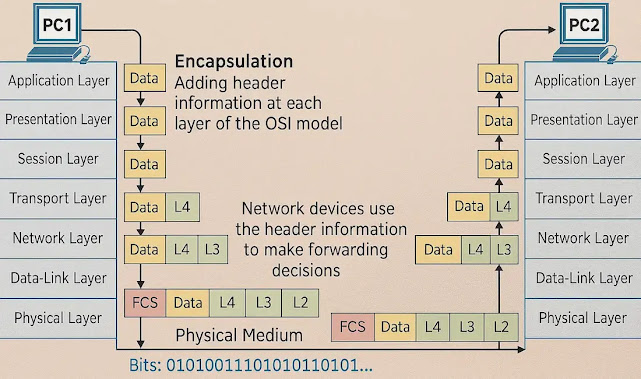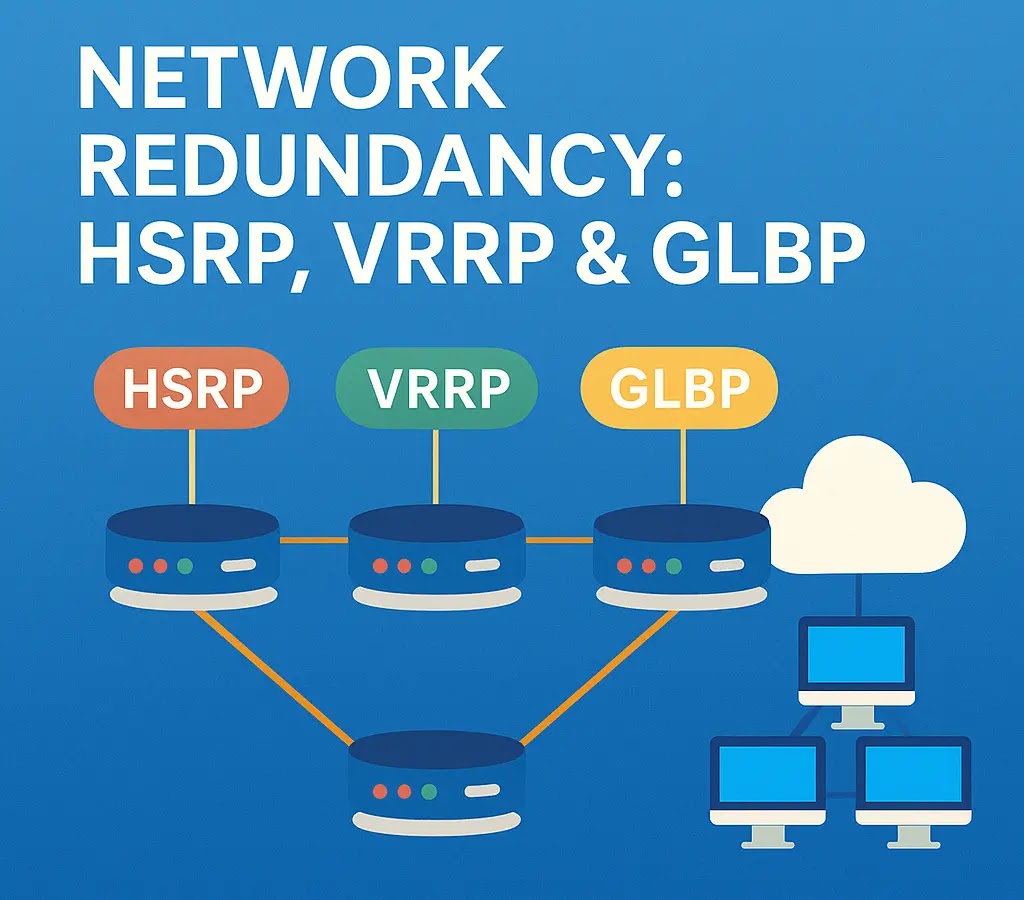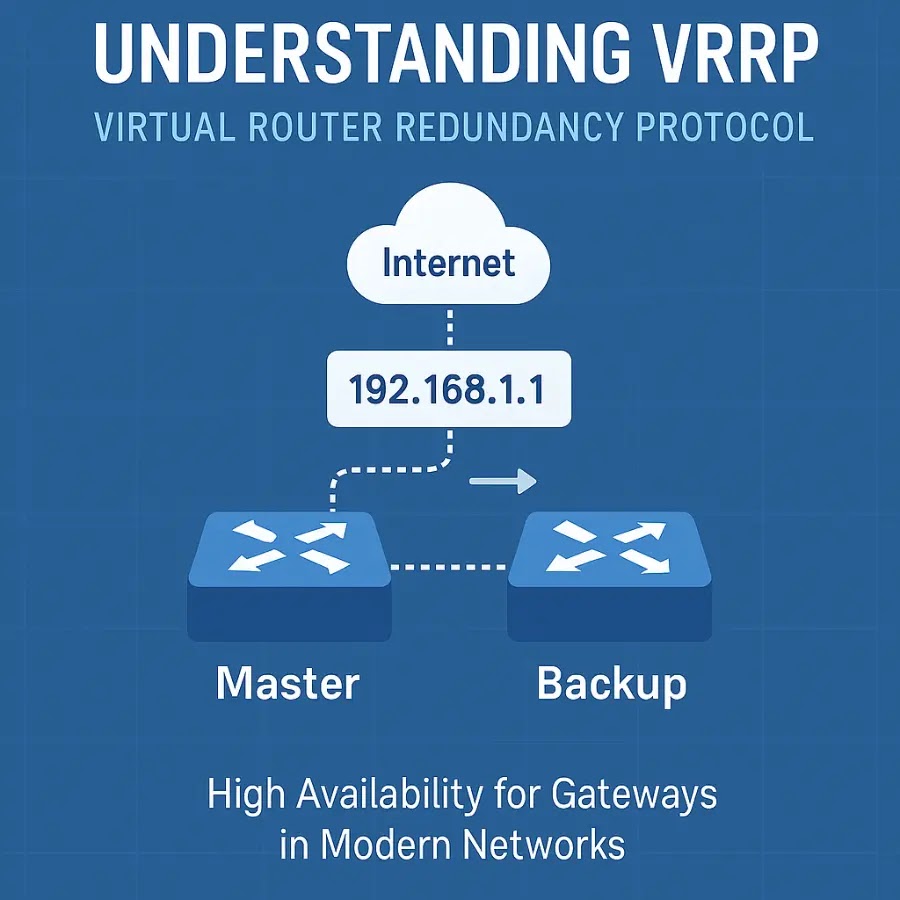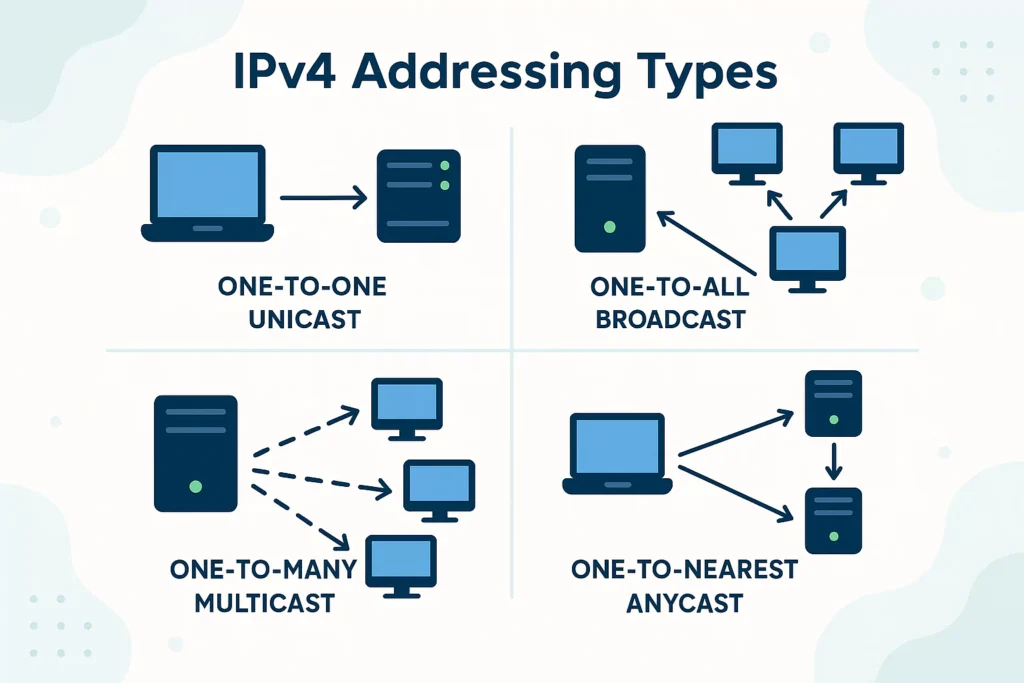
Introduction
IP addressing is the foundation of how devices communicate over the internet and private networks. Without a proper system of assigning and interpreting addresses, data would never know where to go. Earlier, we covered topics like IP address basics, address classes, and NAT. Now, in this article, we move one step further into IPv4 addressing methods.
There are four primary methods: Unicast, Broadcast, Multicast, and Anycast. Each serves a unique purpose and plays a critical role in how information flows. Whether it’s a simple web request, a live video stream, or a global content delivery system, these addressing methods decide how packets are delivered.
In this guide, we’ll break them down with examples, differences, and real-world use cases so that you can clearly understand where each method fits in modern networking.
IPv4 Addressing Basics (Quick Recap)
An IPv4 address is a 32-bit number, usually written in dotted-decimal format like 192.168.1.10. These addresses identify devices on a network and help route packets from source to destination.
Each IPv4 address has two parts:
- Network portion: Defines which network the device belongs to.
- Host portion: Identifies the specific device on that network.
Depending on the purpose, the same 32-bit address space can be used for different communication models. That’s where the addressing methods—Unicast, Broadcast, Multicast, and Anycast—come into play.
1. Unicast Addressing
Unicast is the most common type of communication in IP networks. It simply means one-to-one communication. A single sender sends packets to a single, unique receiver.
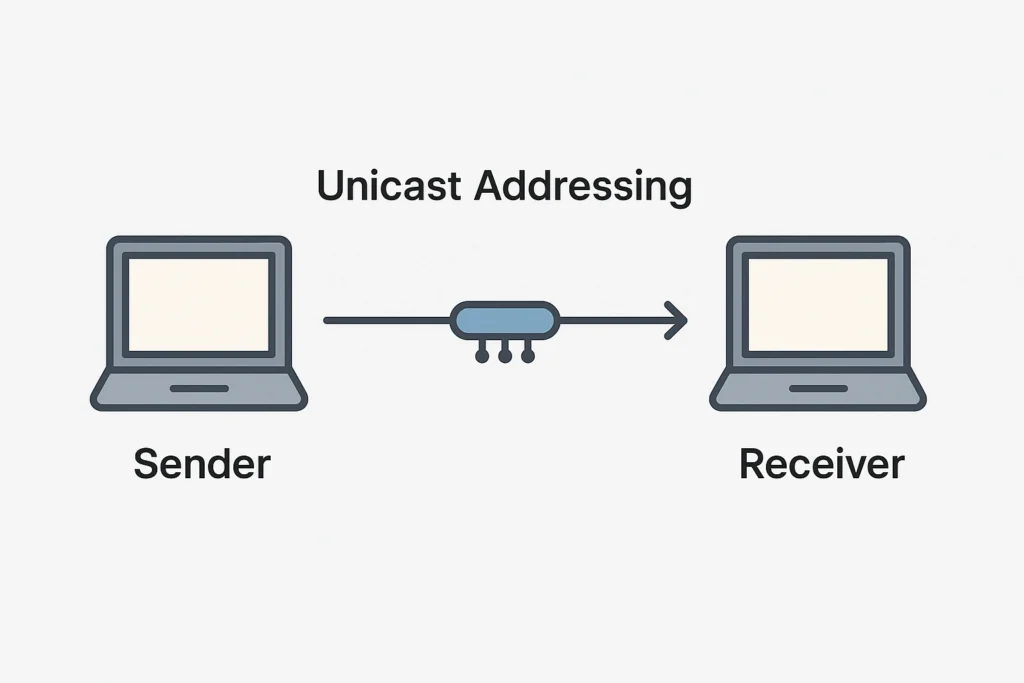
How it works
- The source device has an IP, for example,
192.168.1.5. - The destination device might be
192.168.1.10. - Data is sent directly from one host to the other, across the network path.
Real-world examples
- Opening a website (your PC sends a unicast request to a web server).
- Sending an email.
- Remote desktop connections.
Unicast is efficient for normal web traffic, where the data is only meant for one device.
2. Broadcast Addressing
Broadcasting means one-to-all communication on a local network. A packet is sent by one device and is received by every device within the broadcast domain.
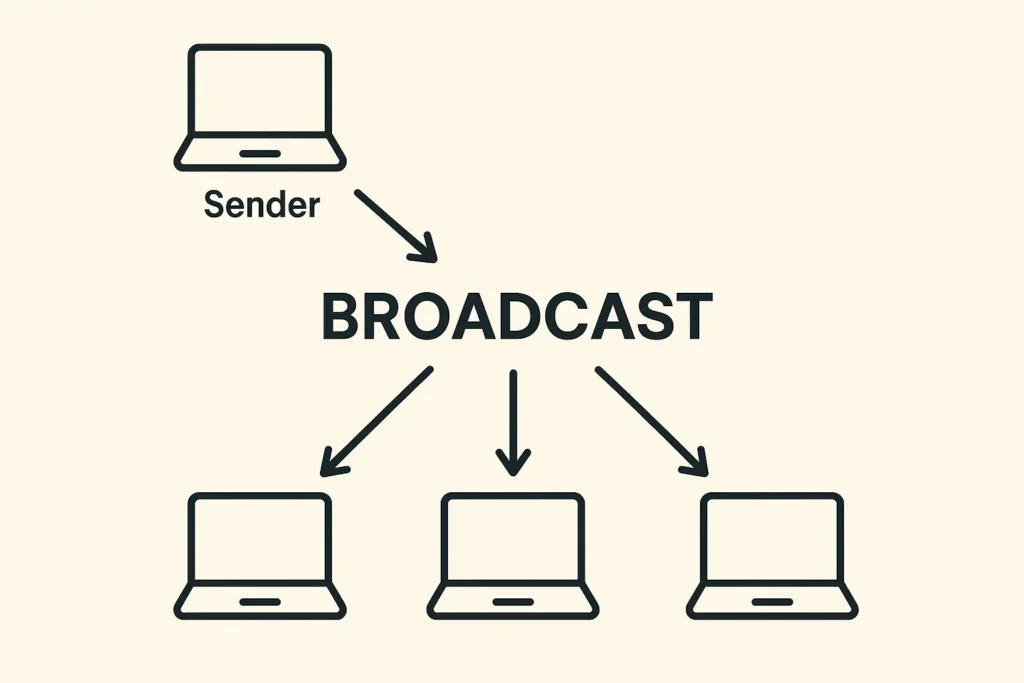
How it works
- Each subnet has a broadcast address (e.g.,
192.168.1.255for subnet192.168.1.0/24). - When a device sends a broadcast packet, all devices in that subnet receive it.
Real-world examples
- ARP Requests (Address Resolution Protocol): When a device wants to know the MAC address of another device in the same LAN, it sends a broadcast.
- DHCP Discovery: When a computer first connects, it broadcasts a request to find a DHCP server.
Limitation
Broadcasting is limited to local networks. Routers usually block broadcast traffic to prevent unnecessary congestion across networks.
3. Multicast Addressing
Multicast is one-to-many communication, but only to a specific group of devices that have opted in to receive the data. This makes it much more efficient than broadcast.
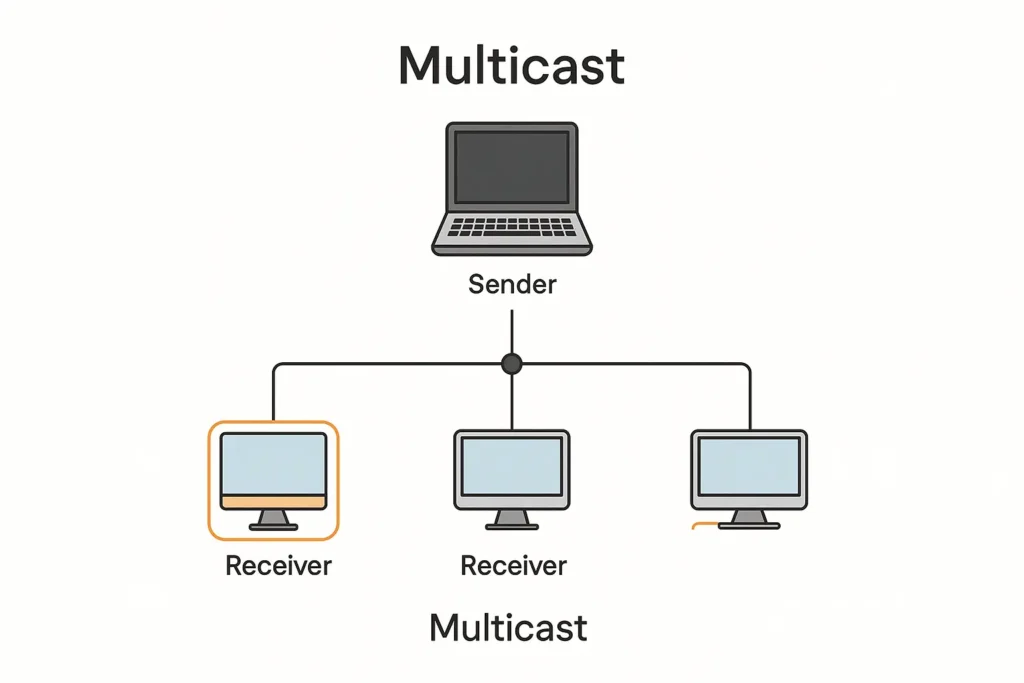
How it works
- Special IPv4 range:
224.0.0.0to239.255.255.255. - Devices subscribe to a multicast group (e.g.,
239.1.1.1). - The sender sends data once, and it gets delivered to all subscribers.
Real-world examples
- Live streaming of sports events.
- Online video conferences.
- IPTV services.
Why it matters
Instead of sending individual streams to thousands of users (like unicast), multicast allows a single stream to be shared with multiple subscribers. This saves huge bandwidth.
4. Anycast Addressing
Anycast is one-to-nearest communication. Multiple devices (usually servers) share the same IP address, and traffic is routed to the closest one based on routing metrics.
How it works
- Imagine three servers across the globe, all sharing the same IP.
- A user in India gets routed to the server in Mumbai, while a user in Germany is routed to Frankfurt.
- Both see the same IP, but each connects to the nearest server.
Real-world examples
- CDNs (Content Delivery Networks): Cloudflare, Akamai, and Google use Anycast to deliver fast content.
- DNS Root Servers: Anycast ensures global availability and redundancy.
Why it matters
Anycast improves performance, load balancing, and fault tolerance. If one server goes down, traffic is automatically redirected to the next nearest one.
Comparison Table of IPv4 Addressing Types
| Addressing Type | Communication Pattern | Example Use Case | Scope |
|---|---|---|---|
| Unicast | One-to-one | Web browsing, SSH | Global |
| Broadcast | One-to-all | ARP, DHCP | Local subnet only |
| Multicast | One-to-many | IPTV, video conferencing | Specific group |
| Anycast | One-to-nearest | DNS, CDN | Global / routing-based |
Practical Applications and Network Design Considerations
Understanding these addressing methods is not just theory—it helps in real-world network design and troubleshooting.
- Troubleshooting: Knowing that ARP requests are broadcast, or that multicast requires group subscription, helps network engineers quickly diagnose issues.
- Security considerations: Broadcasts can be abused for network scans or DoS attacks. Multicast traffic, if not controlled, can overwhelm devices. Anycast, while powerful, requires careful routing configuration.
- Optimization: Enterprises use multicast for software updates across thousands of PCs. CDNs rely on Anycast to serve billions of requests with minimal delay.
Why These Addressing Methods Still Matter in 2025
Even with IPv6 adoption, IPv4 is still everywhere. Understanding unicast, broadcast, multicast, and anycast is crucial for:
- Network engineers managing enterprise LANs.
- Security professionals analyzing attack patterns.
- Developers and cloud architects building applications that scale globally.
Everyday actions—from watching YouTube, to using Zoom, to resolving DNS—depend on these methods quietly working in the background.
Conclusion
IPv4 addressing methods: Unicast, Broadcast, Multicast, and Anycast; form the backbone of how data flows on networks. Each serves a distinct purpose, from one-to-one communication to global service distribution.
By understanding these, you’ll not only be able to design more efficient networks but also troubleshoot and secure them better.
In the next part of our IPv4 series, we’ll dive deeper into special IP addresses and how they’re used in different scenarios.
🔎 Explore More
If you’re following our IPv4 series, here are the previous articles you might want to revisit:
- IPv4 Addressing Explained
- IPv4 Address Classes
- Understanding Subnetting, CIDR and VLSM
- Private and Public IP Addresses + NAT
📚 Outside Sources
Cybersecurity blogger with a focus on firewalls, network security, and tech trends making security simple for everyone, from IT pros to curious minds.
